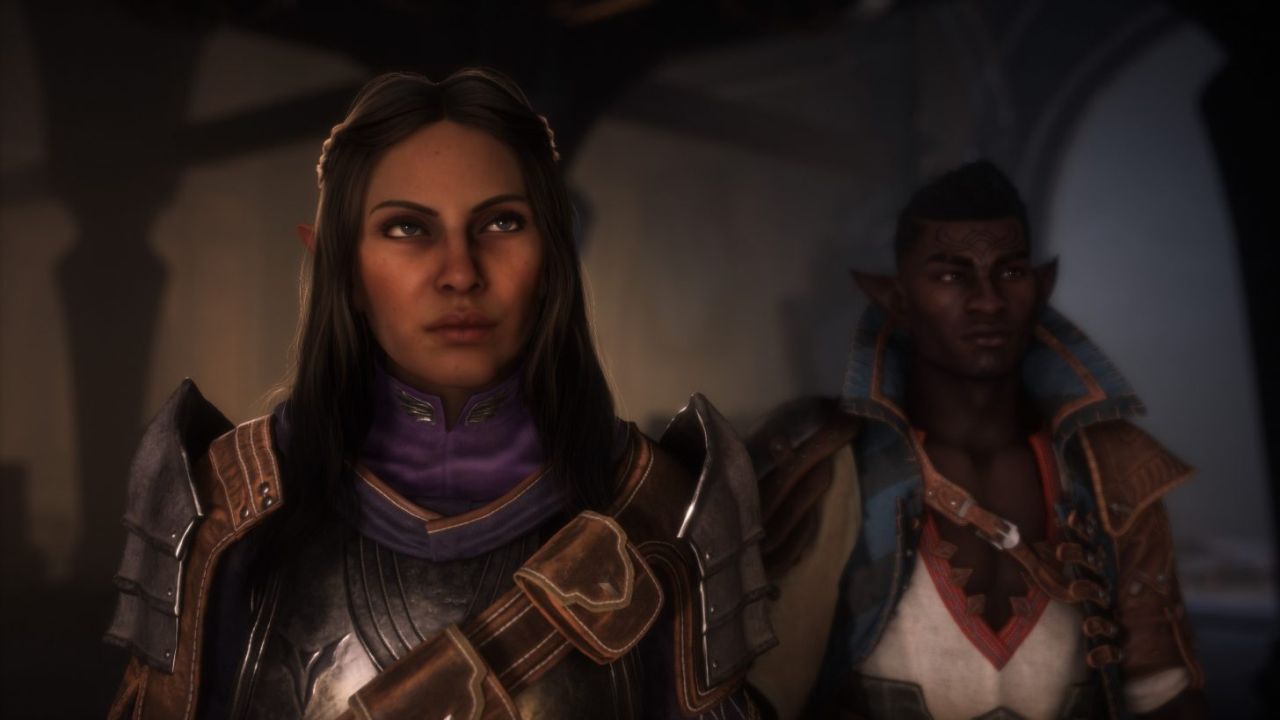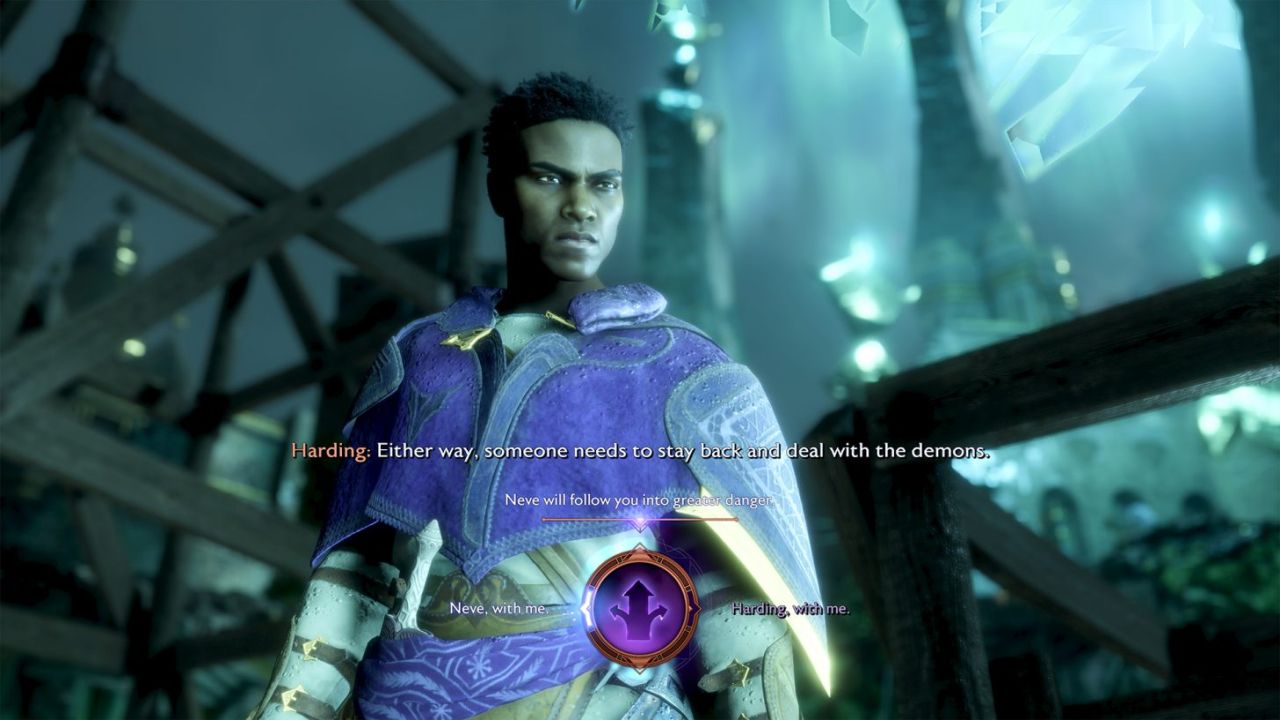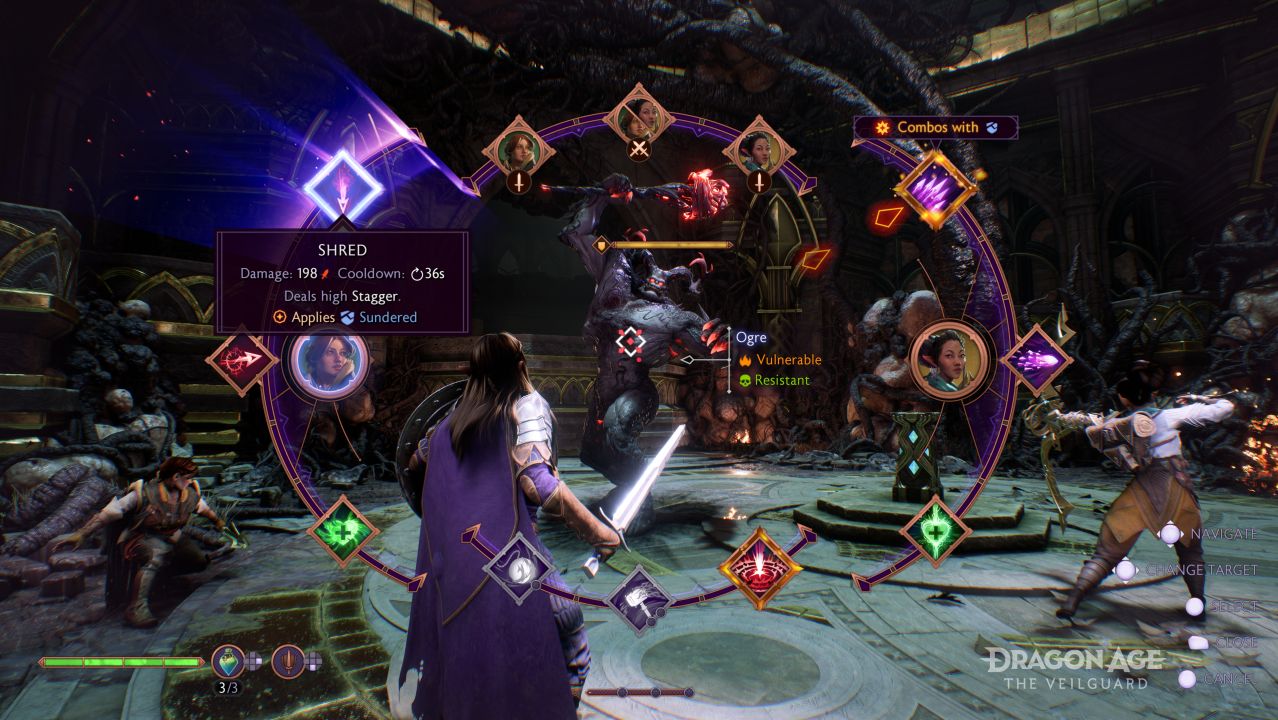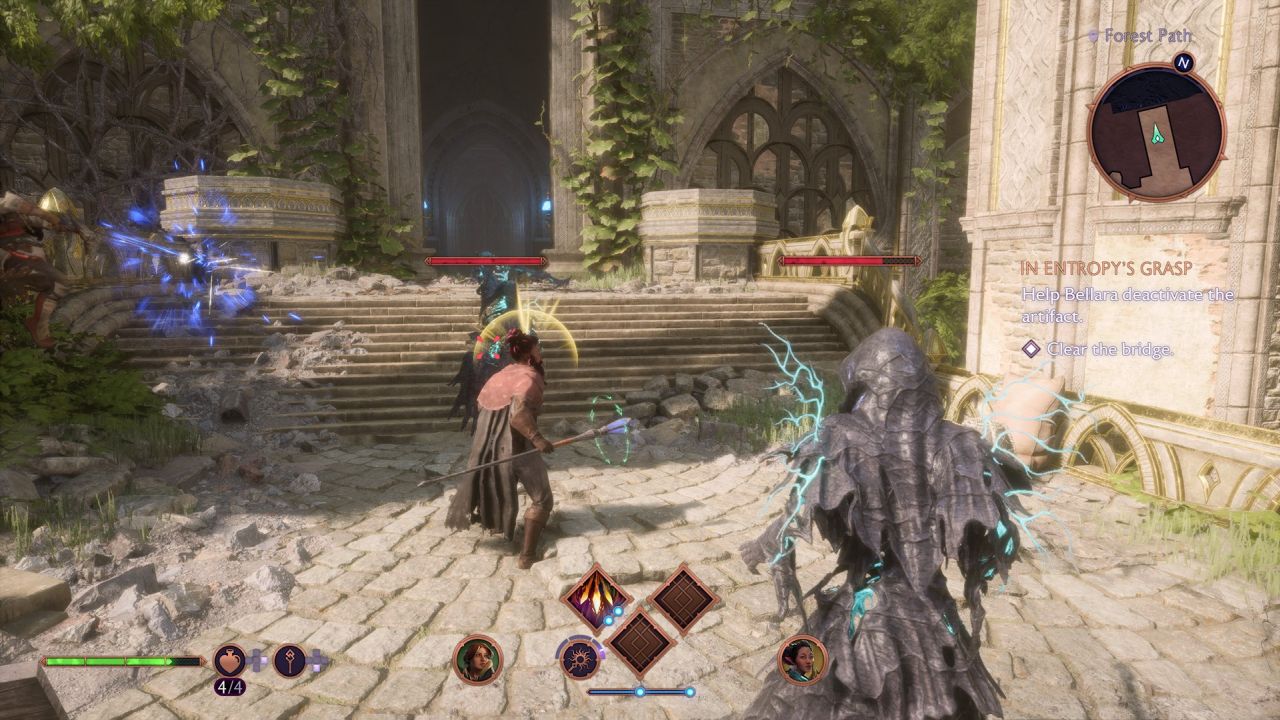Dragon Age: The Veilguard Review
Fantasy RPG series returns with a solid effort
Despite finding early success or even reaching cult status, some franchises take long breaks between entries. From Bloodborne to Okami and Days Gone, a follow-up entry may not even be on the cards, while other franchises, such as Psychonauts, Baldur's Gate, and even Fallout, take a significant amount of time. Developer BioWare have gone through a lot of turbulence over the past decade, including a few cancelled games, which may explain why it's been so long since the most recent Dragon Age entry. The RPG series started out with a strong debut in 2009 with Origins, and got sequels in 2011 and 2014, but has since been dormant. Thankfully the series is not ready to call it quits yet, with the recent launch of Dragon Age: The Veilguard. Much has changed in the time since the previous entry, and the title reflects that.

Dragon Age: The Veilguard places you into the role of Rook, a leader in the making. You have been recruited by Varric, one of the members of the Inquisition from the previous game, to assist in his quest to find and stop Solas. Also known as the Dread Wolf, he is a conflicted elf-god that has travelled across the continent of Thedas, in search of a way to break through the Veil, a magical barrier that stops demons and other evil from crossing into the world. Rook and the group interrupt the ritual, but not before Varric is seriously injured and Solas gets trapped in the Fade, a sort of space between worlds. The group is also able to escape into the Fade, where they setup shop in the Lighthouse, a base of operations that is surrounded by some islands that contain magical portals to different parts of the world. Oh, and it also happens that the ritual did partially succeed in letting free two ancient and angry Elven gods, who now seek to destroy the world and finish breaking apart the Veil fully. With Rook emerging as the new leader, this Veilguard group must find allies, stop ongoing troubles caused by the gods in different parts of the world, and eventually defeat them to stop their plans.
The title weaves a decent fantasy RPG story. It's got all the trappings of a typical western RPG adventure, with a decent cast of characters, a potentially complex anti-hero in Solas, and the pure-evil Elven gods. A few returning franchise characters also make an appearance, but because it's been so long since the last game, there's no opportunity for a direct continuation or a save game import. Players get to create their character and customize their body and face with a decent amount of sliders, as well as pick some brief options about the state of the world, and what occurred in Inquisition. It's likely going to be challenging to remember your choices from that game, so you can leave things as default as well. You also get to pick a background story, though all of these elements are handled at surface level, with some dialogue later on that references your chosen history.
The writing and dialogue on the whole are also quite decent, as Veilguard's medieval fantasy fare falls into a middle ground between the likes of Baldur's Gate 3 and God of War. It doesn't have the chops to measure up to the quality and depth of the former, but it thankfully narrowly avoids the terrible immersion-breaking Marvel-style dialogue of the latter. The conversations have plenty of modern mannerisms mixed with some lore, and it keeps proceedings very brisk and unburdened. That is despite the fact that you might sometimes observe some horrific events and the blood is ever-present during combat. Things flow along at a decent pace and the focus of narrative delivery seems to be accessible for as many players as possible.

Over the course of the story, you'll have plenty of conversations with various characters, including your companions. Most of the dialogue options offer a choice of three answers, being friendly, funny, or stern. These choices don't really influence much beyond the conversation itself and the role-playing. At some points, additional options can also appear, such as anger, sadness, and so on, but they are of similar surface level value. The more important dialogue responses carry the directional symbol that acts as a soft choice on how to respond to a situation or conversation, which will have some effect on either the proceedings or feelings. And of course, there are some rare choices that have no middle ground, as you must pick a path, and hope things work out elsewhere.
While there is plenty of talking, most of it is tied to a quest or storyline; there is very little in terms of optional dialogue, or initiating a conversation with anyone outside of predetermined moments. You can't just leisurely chat with other group members, or catch up with a character from previous games, who stand around. They only speak to Rook when it's time, and that gives the social element a bit of a rigid feel. Companion interactions and the quests can also fluctuate quite a bit in their quality and intrigue. You can get them gifts, and at least the romance is very spread out and not forced as a key interaction. Still, players who enjoy RPGs with a group of ragtag companions that need leading on a grand adventure, while also dealing with all their personal stuff, will find Veilguard satisfying enough.
Although a few things can be solved with dialogue, there are lots of enemies to fight. Creating your custom Rook character involves picking a class, and the choice is surprisingly limited to just three options: Warrior, Rogue, and Mage. But you don't get to pick your starting skills or assign any category points. Unlike its predecessors, this is a full-on third-person action game, as we've come a long way from the tactical, isometric battles in Origins. Your chosen class defines your style of combat, and the Mage seems like the worst option. Having spent a couple of hours with each, the Warrior and Rogue are the clear benchmarks for what the combat in this title is trying to do, thanks to their melee focus. With the Mage, you just feel both ineffective and too far removed from the action, and have to deal with the friendly AI perhaps not performing to their best, and needing to constantly oversee their actions.
But as a melee fighter, the game really starts to click after a couple of hours, as you engage foes that have blockable and unblockable attack indicators as they swing at you, and you dodge out of the way and roll back into the fray. You can run and jump to deliver a more powerful attack, and with enough damage the enemy stagger meters fill, letting you perform a powerful strike.The action has a surprising amount of variety despite the seemingly limited moveset, as chaining all these actions together with light and secondary attacks, creates an engaging and fun combat system. There is even a secondary weapon that can be switched to, in the case of the Warrior it's the two-handed option, which changes up the style and feel of attacks. The special abilities and attacks range from delivering single target damage to large area of affect blasts.

All of this also means that while the game is playable with keyboard and mouse, it's really more suited to a controller, even on PC. Larger scale battles and boss encounters do run the risk of becoming a bit tedious sometimes, simply because enemies have large shield meters or big pools of health, but the action mostly remains frantic and appealing.The enemies come in a few different varieties, from the blight monsters and the undead, to the demons from beyond the Veil. They may be large or small, fast or slow, ranged/magic based or melee and area-of-effect attackers. The variety of encounters is decent and remains fast paced with target prioritization being a factor.
The combat is very action oriented, and while RPG elements like enemy weaknesses and attack combinations do have an effect, they are not a hard requirement on Medium difficulty. There are some tougher fights that may need careful planning and more pauses, as the limited health potions you carry can only be replenished by a few green vases around the area. Some levels and areas have lots of health, while others not as much. But you don't have to adjust your loadout or worry too much about the next fight, as long as there is a healing skill in the group.
Narrative elements and "picking favorites" aside, the two companions that can come along on quests do matter in combat, so their skills and loadouts are somewhat important. The action can be paused at any time, as a big radial menu fills the screen and lets you manually issue orders for your companions, and even queue up special attacks for Rook as well; this is reminiscent of the Mass Effect games. Helpfully, getting this pause in combat also produces useful tooltips, such as elemental strengths and weaknesses of the target enemy, as well as letting you chain special abilities together. It makes it easy to create powerful blasts of damage that are fun to observe.
The special abilities/attacks are a cornerstone of the combat, as aside from dealing damage on their own or creating other effects such as temporary invincibility, they can also be combined. Some attacks apply a special condition, such as sundered or weakened, while others can then detonate that condition for an extra oomph of damage. The game helpfully indicates such abilities on the companion selection screen before missions, without having to delve into the skill trees. This kind of streamlining is welcome, and helps move things along.
What's perhaps less intriguing is the lack of depth in other areas. Earning experience and levelling up just produces skill points, which can be assigned to an admittedly very expansive skill tree for the player. The skill tree is vast and can grow in many directions, leading to specializations and passive boosts, as well as new special abilities (though limited to 3 that can be equipped). Beyond that, however, there is no assigning of stats or other character growth. Companions also get their own skill trees, though shortened versions, and can get new specials as well. All skill point assignments can be refunded at any time for no cost.

You will find loot, but the majority of it is generic treasure that is just meant to be sold to vendors en masse. The inventory consists of typical weapons and armor, and some ring and amulet slots. But you will find very little of them in the world – instead, you are meant to keep what you have for long stretches, and upgrade when possible. Your loot will even get auto-upgraded when you find the same items during exploration, so there is really not much to manage. Similarly, there is gear that is specific to companions, usually found or can be bought from vendors at the map locations where the companion is from or has historical ties to.
So, there is no item management, so to speak. Inventory gear can’t even be sold or dismantled. You can buy more powerful items from vendors after earning their trust and upgrading their wares, which is done by visiting the areas of the map where they operate and earning relationship points with the faction that resides there. But the selection is scarce, so you might choose to upgrade instead. Upgrades cost gold and materials, but provide decent boosts. You can also enhance gear, which surprisingly costs nothing, with good passive stat bonuses or effects. Although you won't be dealing with vendors much, the game's UI is a bit inconsistent – sometimes interactions require a longer press to confirm the desired action, while at other times (such as upgrading vendor level) it is a single button press, which can be done accidentally and can be costly due to the large material amount needed. Still, whether you've perished in battle or performed the wrong upgrade, the game is trying to be accessible as possible – it autosaves extremely frequently, and even has special "temporary decision saves" in case you choose the wrong dialogue options. Save scumming made easy, it seems, in a game that really doesn't need it.
While the movement feels weighty in combat, it's a bit more clumsy during exploration and terrain navigation. Being able to sprint and jump across gaps leads to a lot of environment interaction and walking on beams, though all of it carefully staged. New locations typically take you through their opening areas via a story mission, and after that you are able to return and explore them more freely, as well as pick up more optional quests to delve deeper into the map. It's very predictable design, albeit decently executed, as you'll find plenty of doors that will remain locked until the game decides you can enter with a specific quest or companion. Unlike Inquisition, Veilguard is more of a linear experience with distinct levels and pathways to navigate across. That's not to say there's no surprises – the game does a good job of weaving in the occasional puzzle and a ton of side rooms. All of these side rooms contain satchels and chests – dare we say, a few too many. You find something to pick up near-constantly, and it seems a bit excessive, with so much random stuff to collect even down in the deepest dungeons and forgotten caves. The puzzles also follow a rather disappointing and predictable nature; you are rarely thinking about how to do something, but rather how to get somewhere. A lot of progress is halted by a repetitive task of eliminating crystals or other objects in a specific linear order.

Fast travel nodes at least expedite exploration and let you swap party members without leaving the map. You can also travel to new maps right away, without exploring the floating islands in the Fade where the Lighthouse base is, to find the right teleporter magical mirror, which can get tedious. But you will have to run around between the big rooms of your companions, which are fairly spread out. In your own private chambers, you can customize the room with some artefacts and other objects, as well as update your visual appearance. Veilguard allows MMO-style gear skin management, so you can look however you want, regardless of what you actually have equipped.
Exploring the game's maps and doing quests for the faction in each location leads to improving their strength, which as you might expect may become a factor as the narrative leads into the finale. Keeping a strong bond with your companions is important for similar reasons, so bringing them on adventures and quests helps not only gameplay variety but also the narrative. There is some banter between the characters you bring along, but it's not particularly memorable.
The voice acting and sound design are decent, just like the writing. The facial animations are good for an RPG, but some of the combat can get a bit wild and the physics occasionally goes out of whack. But perhaps more divisive will be the game's art style, which uses lots of bright colors, and smooth character models that have a bit of a cartoon-ish look to them. It's a style that fits the somewhat cheery voice acting and story, despite all the blood and bad things that sometimes happen, so there's a bit of an internal conflict with the game's visual themes and content. It's a bit reminiscent of EA's own Immortals of Aveum. But what this art style does allow for is some rather great fantasy environment design. The levels are quite excellently presented, from the deep forests and dark caves, to the sunny beaches and dark caverns of necromancy. These may be fairly typical locales for a medieval fantasy adventure, but they are wonderfully realized.
The nice visuals also run decently well. The game was able to maintain a steady framerate at the near-highest setting on our medium-spec build, but there were some jarring dips when too many magical attacks hit too many enemies at once. The game supports DLSS /AMD FSR, and ray tracing. We didn’t experience any crashes or quest bugs throughout the 30+ hours with the game. This release also forgoes any microtransactions or in-game shop, and has no always-online requirement, which is nice to see.

In a way, Dragon Age has been a reflection of the times. It began in late 2000s, when the hardcore PC RPG market still existed in the mainstream, which Origins aspired to be. The sequel that followed came at a time when edgy and dark themes were all the rage, and its themes and protagonist matched that, along with a more accessible take on the combat. Inquisition arrived when open world games were peaking, and so it too followed that formula. With Veilguard, the series has a bright and colorful art style, removed much of the complexities of the genre (even for a western RPG), and evolved to rapid third person combat, which is on trend for the modern games market. All of it comes together into a compelling and well put together adventure, even if it doesn’t excel or innovate in any particular area. In a way, Veilguard is to the Dragon Age franchise as The Outer Worlds is to Fallout. It's a lighter and more accessible take on an ages-old formula, and one that is fun to play through. At the end of the day, and the decade, the franchise returns to show that it still has something worthwhile to offer.
 Comments
Comments



















